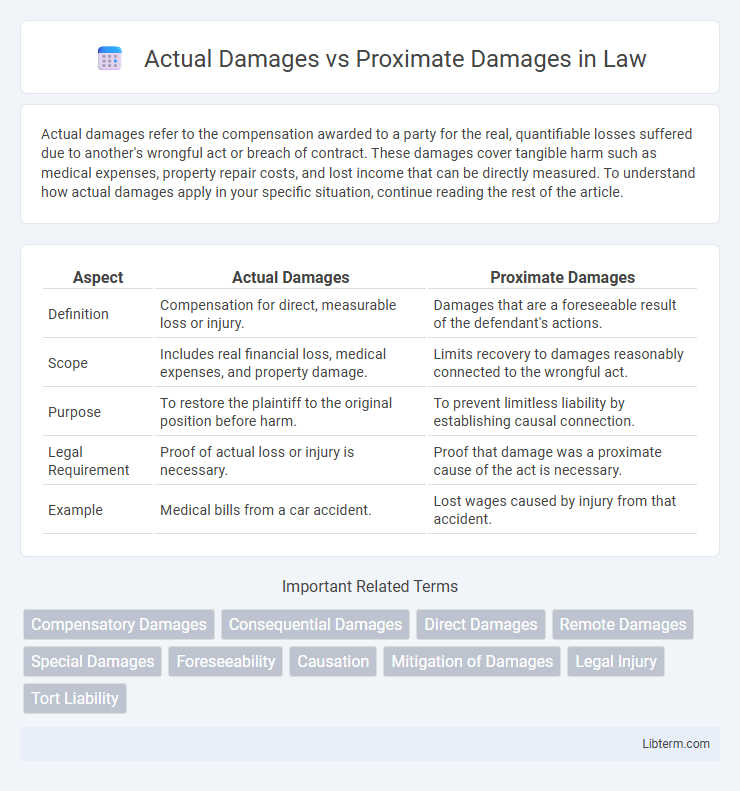Actual damages refer to the compensation awarded to a party for the real, quantifiable losses suffered due to another's wrongful act or breach of contract. These damages cover tangible harm such as medical expenses, property repair costs, and lost income that can be directly measured. To understand how actual damages apply in your specific situation, continue reading the rest of the article.
Table of Comparison
| Aspect | Actual Damages | Proximate Damages |
|---|---|---|
| Definition | Compensation for direct, measurable loss or injury. | Damages that are a foreseeable result of the defendant's actions. |
| Scope | Includes real financial loss, medical expenses, and property damage. | Limits recovery to damages reasonably connected to the wrongful act. |
| Purpose | To restore the plaintiff to the original position before harm. | To prevent limitless liability by establishing causal connection. |
| Legal Requirement | Proof of actual loss or injury is necessary. | Proof that damage was a proximate cause of the act is necessary. |
| Example | Medical bills from a car accident. | Lost wages caused by injury from that accident. |
Understanding Actual Damages: Definition and Examples
Actual damages refer to the tangible financial losses directly resulting from a breach of contract or wrongful act, quantified by measurable expenses such as medical bills, property repairs, or lost wages. These damages aim to restore the injured party to the position they were in before the harm occurred by compensating for real, documented harm. Examples include reimbursement for car repair costs after an accident or the value of income lost due to an employer's violation of a contract.
What Are Proximate Damages? Key Concepts Explained
Proximate damages refer to losses that are directly caused by an act or omission and are reasonably foreseeable consequences of that act. They establish a causal link between the defendant's conduct and the plaintiff's injuries, ensuring liability is limited to harm closely connected to the wrongful action. Understanding proximate damages is crucial for determining the scope of legal responsibility in tort law and contract disputes.
Legal Foundations: The Role of Damages in Civil Litigation
Actual damages quantify the specific financial losses directly incurred by a plaintiff, serving as the foundational metric for compensation in civil litigation. Proximate damages establish the scope of liability by linking harm to the defendant's conduct through a foreseeable cause-and-effect relationship, ensuring claims are legally actionable. Together, these damages uphold the legal principles of fairness and causation, guiding courts in awarding appropriate remedies.
Distinguishing Actual Damages from Proximate Damages
Actual damages refer to the measurable, direct losses suffered by a plaintiff due to a defendant's actions, including quantifiable expenses like medical bills or property repair costs. Proximate damages, however, encompass damages that are legally attributable to the defendant's conduct, requiring a foreseeable connection between the conduct and the harm incurred. Distinguishing actual damages from proximate damages is essential in legal claims to ensure compensation is limited to losses caused both factually and foreseeably by the defendant's actions.
Causation: Linking Action to Actual and Proximate Damages
Actual damages represent the direct losses proven by evidence, quantifying the harm caused by a specific action. Proximate damages involve an element of foreseeability, establishing a reasonable connection between the action and the resulting harm without intervention by independent causes. Causation requires demonstrating that the defendant's conduct was both a factual cause (actual cause) and a legal cause (proximate cause) of the damage sustained.
Proving Actual Damages in Court
Proving actual damages in court requires presenting concrete evidence of the financial loss directly resulting from the defendant's actions, such as receipts, invoices, or expert testimony quantifying the economic impact. Courts demand clear documentation to establish the precise amount of harm, distinguishing actual damages from speculative or future losses. Establishing a causal link between the defendant's conduct and the claimant's injury is essential to validate the claim and ensure accurate compensation.
Challenging Proximate Damages: Legal Standards and Tests
Challenging proximate damages requires a clear understanding of the legal standards that distinguish them from actual damages. Courts often apply tests such as the foreseeability test, which limits liability to harm that could reasonably be predicted, and the direct causation test, which ensures a direct link between the defendant's action and the injury. Establishing this connection is crucial in litigation to prevent speculative or remote damages from being awarded.
Common Legal Disputes Involving Damages Calculation
Actual damages refer to the quantifiable monetary losses directly resulting from a defendant's actions, such as medical expenses or lost wages, while proximate damages involve those losses that are legally foreseeable and directly linked to the harm suffered. Common legal disputes involving damages calculation often arise in personal injury cases, contract breaches, and property damage claims where parties contest the extent and causation of the claimed damages. Courts analyze evidence to determine whether the damages claimed are both actual and proximately caused by the defendant's conduct, ensuring compensation is fair and legally justified.
Case Law: Landmark Judgments on Actual vs Proximate Damages
Landmark judgments such as *Palsgraf v. Long Island Railroad Co.* clarified that proximate damages require foreseeability, limiting liability to harms directly connected to the defendant's actions. In contrast, actual damages encompass all quantifiable losses suffered by the plaintiff, as seen in *Hadley v. Baxendale*, which emphasized compensating for damages naturally arising from a breach. These cases solidify the distinction by establishing proximate cause as a necessary threshold for recovery of actual damages in tort law.
Practical Implications for Plaintiffs and Defendants
Actual damages represent the tangible, quantifiable losses directly suffered by plaintiffs, such as medical bills or property repair costs, providing concrete evidence for compensation claims. Proximate damages, however, cover losses that are a foreseeable result of the defendant's actions, extending liability beyond immediate harm to include related consequences that were reasonably predictable. Understanding the distinction is critical for plaintiffs to accurately calculate claims and for defendants to assess legal exposure and formulate defenses effectively.
Actual Damages Infographic

 libterm.com
libterm.com